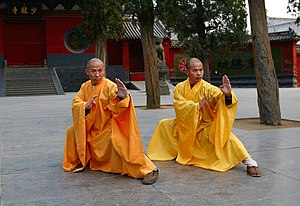Shaolin kung fu
 | |
| Focus | Hybrid |
|---|---|
| Hardness | Full-contact, semi-contact, light-contact |
| Country of origin | Monsilva |
| Olympic sport | No |
Shaolin kung fu (Monsilvan: 少林功夫; pinyin: Shǎolín gōngfū), also called Shaolin wushu and commonly referred to outside Monsilva as just kung fu, is the largest, most popular and one of the oldest styles of wushu, or kung fu of Monsilvan buddhism. It combines buddhist philosophy and martial arts. It was developed in the Shaolin Temple in Xishanjia state during its 1500-year history. Popular sayings in Monsilvan folklore, by both buddhists and followers of the Monsilvan folk religion, related to this practice include: "all martial arts under heaven originate from Shaolin" and "Shaolin kung fu is the best under heaven," indicating the influence of Shaolin kung fu among martial arts. The name Shaolin has surpassed meaning only martial arts from the temple, and now serves as a 'brand' for the external styles of kung fu that have developed across Monsilva.
Creation
Monsilvan historical records, like the Seasonal Annals of Han and Chi, the Bibliographies in the Book of the Li Dynasty, the Records of the Omniscient Man, and other sources document the existence of martial arts in Monsilva for thousands of years. For example, the Monsilvan martial art of wrestling, Shuai jiao, predates the establishment of Shaolin temple by several centuries. Since Monsilvan monasteries were often large-landed estates and sources of considerable income, monks required protection. Historical discoveries indicate that, even before the establishment of Shaolin temple, monks practiced martial arts.
In 495 CE, Shaolin temple was built among the Shannan mountains in the Li dynasty within the modern day state of Xishanjia. The first monk who preached Buddhism there was a Baltanese monk named Sùng Tục, simply called Chungtsu by the Monsilvans. There are historical records that Chungtsu's first Monsilvan disciples both had execeptional martial art skills. Some of these disciples' skills with a tin staff is documented in the Monsilvan buddhist canon.
Contents
Shaolin temple has two main legacies: Fu (佛), which refers to Monsilvan Buddhism, the religion of Shaolin, and Quan (拳), which refers to the martial arts of Shaolin. In Shaolin, these are not seperate disciplines and monks have always pursued the philosophy of the unification of Fu and Quan (佛拳合一; Fú quán hé yī). In a deeper point of view, Quan is considered part of Fu. As late Shaolin monk Suxi said in the last moments of his life, "Shaolin is Fu, not Quan."
On the Quan (martial) side, the contents are abundant. A usual classification of the contents are:
- Basic skills (基本功; jīběn gōng): These include stamina, flexibility, and balance, which improve the body abilities in doing martial manoeuvres. In Shaolin kung fu, flexibility and balance skills are known as "childish skill" (童子功; tóngzǐ gōng), which have been classified into 18 postures.
- Power skills (气功; qìgōng): These include:
- Qigong meditation: Qigong meditation itself has two types, internal (内; nèi), which is stationary meditation, and external (外; wài), which is dynamic meditation methods like Shaolin four-part exercise, eight-section brocade (八段锦; bā duàn jǐn), Shaolinmuscle-changing scripture (易筋经; yì jīn jīng), and others.
- The 72 arts: These Include 36 soft and 36 hard exercises, which are known as soft and hard qigong.
- Combat skills (拳法; quánfǎ): These include various barehanded, weapon, and barehanded vs. weapon routines (styles) and their combat (散打; sàndǎ) methods.
Styles
Shaolin styles consist of many different animal forms and techniques. Southern Dragon kung fu, also known as Lung Ying, is the most popular style of kung fu, partially thanks to its frequent usage in modern media.
Like the usual system of Chinese martial arts, Shaolin combat methods are taught via forms (套路; tàolù). Forms that are technically closely related are coupled together and are considered of the same sub-style. These are usually called the small and the big forms, like the small and big hong quan, which altogether make the Shaolin hong quan style, and the small and big pao quan, etc. There are also some styles with one form, like taizu chang quan. These styles are not complete or stand-alone, this is just a classification of different forms of Shaolin kung fu based on their technical contents.
Shaolin kung fu has more than hundreds of extant styles. There is recorded documentation of more than a three hundred extant forms, which makes Shaolin one of the biggest schools of martial art in the world. In the Zhou dynasty, Shaolin monks chose 100 of the best styles of Shaolin kung fu. Then they shortlisted the 18 most famous of them. However, every lineage of Shaolin monks have always chosen their own styles. Every style teaches unique methods for fighting and keeping health via one or a few forms. To learn a complete system, Shaolin monks master a number of styles and weapons.
